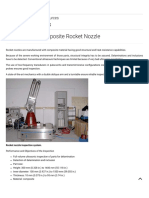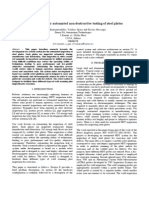Sem
Sem
Uploaded by
aliveinmoscowCopyright:
Available Formats
Sem
Sem
Uploaded by
aliveinmoscowCopyright
Available Formats
Share this document
Did you find this document useful?
Is this content inappropriate?
Copyright:
Available Formats
Sem
Sem
Uploaded by
aliveinmoscowCopyright:
Available Formats
Materials Testing
Scanning Electron
Microscopy
Test No.: M604
Aim: Explanation of the basics of scanning electron microscopy using surfaces of fractures as an
example.
Comparison and analysis of differing fracture behaviour of metallic and polymeric materials
by means of scanning electron microscopy.
Contents
1 Introduction
1.1 Limitations of light-optical microscopy
2 Basics
2.1 Microscopy by employing electron beams
2.2 Interaction between electrons and specimen
2.2.1 Secondary electrons (SE)
2.2.2 Back scattered electrons (BSE)
2.3 Scanning electron microscope (SEM): Design and function
2.3.1 Signal-producing system
2.3.1.1 Generation of the probe
2.3.1.2 Lens system
2.3.1.3 Scanning system / magnification
2.3.2 Signal-processing system
2.3.3 Detectors
2.4 Interrelationship between depth of focus, resolution, and magnification
2.5 Fractographic analysis
2.5.1 Transgranular and intercrystalline fracture
3 Technological significance
3.1 Assessment of damage
3.2 Quality assurance and quality control
3.3 Medical examination and biological investigation
4 Testing
5 Evaluation of testing
6 Questions
7 Bibliography
Test M604: Scanning electron microscopy
2
1 Introduction
Minor defects often result in considerable damage. Small fractures or cracks in materials can have
disastrous effects on the stability of buildings, tools, etc. Once an accident has happened, its
causes have to be found. A microscope examination of the fracture surface shows whether a
material defect or a processing defect has caused the fracture. Light-optical and electron-optical
microscopes are used for this purpose. Electron microscopes are advantageous in that a high
degree of magnification as well as an excellent depth of focus (Fig.1) can be achieved. As a rule,
surfaces of fracture are very rough so that a light-optical microscope often cannot produce a
sufficiently clear enlargement of the relevant image section.
Fig. 1: Photo of blood corpuscles taken by means of a) a light-optical microscope and b) an electron-optical
microscope (same magnification).
1.1 Limitations of light-optical microscopy
The amount of information a micrograph can provide is dependent on resolution. The maximum
resolution that can be achieved using a microscope means the smallest interval distinguishable
between two adjacent points. Any magnification exceeding such maximum would not make sense
since further information cannot be provided.
The maximum resolution mainly depends on the wavelength of the radiation selected for the
image. Beams entering the lens- and aperture system of the microscope produce overlapping
diffraction patterns for each object point. The distance r
1
between two diffraction maxima must
exceed full width half maximum (FWHM), otherwise the diffraction maxima cannot be discerned
as being separate (Fig. 2). According to a simple rule found by Rayleigh, distinction is possible
when the maximum of the zero order coincides with the first minimum of the second diffraction
pattern. The distance between the two first minima d
1
is inversely proportional to the diameter of
the aperture.
Test M604: Scanning electron microscopy
3
Fig. 2: Minimal distance between two diffraction maxima still projected separately
Diffraction patterns are dependent on the wavelength , on the index of refraction of the
surrounding medium , and on the angle formed by the optical axis and the edge beam, which
can only just pass through the aperture. For r
1
results:
sin
61 , 0
2
1
1
d
r (1)
The product sin is referred to as numeric aperture.
Thus, high resolution can be achieved by a short wavelength, a high index of refraction of the
surrounding medium, and a short distance to the sample (hereinafter also referred to as
"specimen") (wide angle ). When normal light-optical microscopes are used, the surrounding
medium is air ( = 1) and the distance between sample and lens cannot be decreased at discretion.
For this reason, the maximum resolution with regard to wavelengths of visible light (400 - 700
nm) is limited to about 200 nm, and any degree of magnification beyond 1000 would not make
sense.
2 Basics
2.1 Microscopy by employing electron beams
(Hereinafter the term "electron beam is also referred to as "probe"). If electrons are used instead
of optical waves, much smaller wavelengths can be achieved. The wavelength can be varied
depending on the voltage set to accelerate the electrons towards the sample. The velocity v of a
single electron can almost reach the velocity of light c. In that case, relativistic corrections become
necessary. The electron mass changes according to the following equation:
2
1
2
1
]
]
]
]
,
`
.
|
c
v
m
m
e
, ( 2 )
m
e
is the rest mass of the electron.
The deBroglie relation determines the interrelationship between wavelength and momentum.
mv
h
p
h
, ( 3 )
h is Plancks quantum (constant of action). The energy transmitted to an electron eV can be
equated with the energy of relativistic mass changes:
( )
2
c m m eV
e
(4)
By means of these three equations the dependence of wavelength on accelerating voltage can be
derived:
Test M604: Scanning electron microscopy
4
,
`
.
| +
2
2 2
2
2
2
c
V e eVm
h
e
(5)
( )
nm
V V
2
1
2 6
10
5 , 1
]
]
]
(6)
An accelerating voltage of e.g. 20 kV results in 8.6E-3 nm = 8.6 pm, whereas at 500 kV only
1.4E-3 nm are reached.
Since electrons would be too strongly scattered in air, a high vacuum is required in an electron
microscope. In addition, the samples to be tested have to be electrically conductive, otherwise they
would be overcharged with electrons during irradiation. For this reason, conductors and insulators
of inferior quality have to be coated with a conductive layer of metal or carbon prior to
microscopic investigation.
2.2 Interaction between electrons and specimen
Electrons in scanning electron microscopes are accelerated at voltages in the range of 2 to 40 kV.
An electron beam < 0.01m in diameter is focused on the specimen. These fast primary electrons
(PE) interact in various ways with the surface layers of the specimen. The zone, in which such
interaction occurs, and in which different signals are produced, is called "interaction volume" or
"electron diffusion cloud". The size of the interaction volume is proportional to the energy of
primary electrons, its shape is determined dependent upon scattering processes by the mean atomic
number. Secondary electrons (SE), back scattered electrons (BSE), and absorbed electrons are
produced, flowing off as specimen current. In addition, X-rays, Auger electrons, and
cathodoluminescence are produced (Fig. 3).
Fig. 3: Interaction volume
R: The range of primary electrons (PE);
T: Escape level for back scattered electrons (BSE)
Resolution limit of BSE R
Resolution limit of X-radiation interaction volume
Resolution limit of secondary fluorescence > interaction volume
Test M604: Scanning electron microscopy
5
2.2.1 Secondary electrons (SE)
Although secondary electrons are produced in the entire interaction volume, they can only escape
from surface layers (metals: max. 5mm, insulators: max. 50 mm, Fig. 4: Escape level t).
Secondary electrons are very slow, their escape energy is 50 eV. Approximately half of all SE
are produced very near to the point of impact of PE (SE1). Owing to back scattered electrons
(BSE) diffusing in the specimen material, SE are also produced at a distance in the range of 0.1 to
some m to the point of impact (SE2). Back scattered electrons reacting with the wall of the
specimen chamber are the third source of SE. This reaction process causes background radiation
and thus a smaller degree of contrast, which, however, can partly be increased again electronically.
(Fig. 4)
Fig. 4: Production of SE and BSE
The best lateral point resolution can be achieved by means of SE1. The signal can be intensified
when the primary beam hits the samples at an angle of < 90; this is referred to as inclination
contrast. If radiation can penetrate specimen structures such as tips, fibres, or edges, the images of
these structures will be very bright (edge contrast) owing to a high SE yield.
The SE signal, comprising all essential information on topography, produces electron-micrographs
of high resolution.
Fig. 5: SE yield is dependent on the atomic number Z
2.2.2 Back scattered electrons (BSE)
The electrons escaping from the surface of the sample and having an energy of 50 eV are
referred to as back scattered electrons (BSE). BSE are produced in the entire interaction volume at
a larger distance to the point of impact of PE (Fig. 4). When atomic numbers are low, the escape
Test M604: Scanning electron microscopy
6
level T is approx. half the range R; at accelerating voltages > 20kV and when atomic numbers are
high, the escape level T is lower. The higher the PE energy and the smaller the atomic number of
the specimen material, the more extends the area of production of BSE and the lower the
achievable resolution. However, the dependence on the atomic number of the sample material is
an advantage in that, apart from the topography contrast, a material contrast can be made visible.
Moreover, owing to higher energy charging occurs less frequently than in case of SE.
Fig. 6: RE yield is dependent on the atomic number Z
2.3 Scanning electron microscope (SEM): Design and function
The surface of a specimen is brought into the focus of electron beams. The signals produced
control the brightness of a screen tube such that an image of the surface of the sample appears.
Fig. 7 illustrates the basic design of a scanning electron microscope.
Fig. 7: Basic design of an SEM
In a scanning electron microscope the signal-producing system and the signal-processing system
operate independently.
Test M604: Scanning electron microscopy
7
2.3.1 Signal-producing system
The signal-producing system (see Fig. 7 to the left and Fig. 8) is to generate a probe of the
smallest diameter possible and of maximum brightness when hitting the surface of the specimen. It
consists of an electron gun, (cathode Wehnelt cylinder anode), lens system (lenses, apertures,
beam deflection coils and stigmator coils) and the specimen chamber.
Fig. 8: Course of the probe in the signal-producing system
At least two pumps are required to reduce pressure to a vacuum. A vane-type rotary pump
produces a pre-vacuum of approx. 10
-3
mbar. Either a turbomolecular pump or an oil diffusion
pump maintain the operation vacuum of at least 10
-5
mbar in the column and in the chamber.
Dependent upon the type of cathode used, a third pump, the ion getter pump, may be operated.
For further information please refer to technical literature!
2.3.1.1 Generation of the probe
In the field of electron microscopy free electrons are usually produced by thermal emission. Other
microscopes operate by means of field emission (> 10
9
V/m). Mostly, tungsten filaments or - as
described here - LaB
6
-crystals serve as cathode. The electron emitter consists of a three-electrode
arrangement (Fig. 9).
Test M604: Scanning electron microscopy
8
Fig. 9: Basic design of an electron gun.
An electric heating current heats up the filament on the negative potential (cathode) opposite the
anode. The relevant accelerating voltage accelerates the emitted electrons towards the anode where
they pass through a gap to enter the microscope column. The filament is situated in a Wehnelt
cylinder so that the electrons can be focused. The potential of the Wehnelt cylinder is slightly
more negative than that of the filament. The Wehnelt cylinder focuses the electrons by emitting
them from one point. This point, also referred to as virtual electron emitter or as cross-over, can be
shifted by a variable bias resistance. The Wehnelt cylinder does not only adjust the diameter of the
cross-over but the number of electrons leaving the cathode (emission current).
2.3.1.2 Lens system
Magnetic lenses and various apertures focus the electron beam. When an electron with the
charge e and the velocity v reaches a magnetizing field of the intensity B, force F acts on the
electron such that the force vector F is perpendicular to the velocity vector v and the magnetizing
field vector B.
) ( v B e F (7)
Fig.10: Force vectors of a charge moving in the magnetizing field
Test M604: Scanning electron microscopy
9
The magnetizing field of an electromagnetic lens can be divided into an axial and a radial part.
The axial part, running in parallel to the direction of movement of the electron, does not influence
the electron. The radial part, however, forces the electron to take a helix-path by the force
(B
rad
e v). Thus, due to such circular component the velocity vector is influenced by the axial
magnetizing field (B
ax
e v
zirk
). As a result the radius of the helix-path is becoming ever smaller.
The electromagnetic lenses of an SEM produce an image reduced in diameter of the cross-over in
the gun on the surface of the specimen. Two condenser lenses (Fig. 8) reduce the diameter of the
electron beam (the diameter of the electron beam is also referred to as "probe size") from d
0
to d
2
.
The higher the lens current, the smaller the diameter (Fig. 11).
Fig. 11: Schematic illustration of the probe a) low, b) high lens current
The smaller the probe size, the smaller the portion of electrons reaching the specimen since not all
electrons leaving lens 1 can pass through lens 2. (Fig. 11):
1 2
< . Increasing noise results,
limiting the resolving power of the SEM.
The third lens, i.e. the objective lens, focuses the probe towards the specimen.
Lens holes which are not absolutely symmetrical mechanically, whose magnetizing fields are
inhomogeneous, and whose pole piece holes are contaminated, and contaminated apertures in
particular, will result in an elliptical probe producing "axial astigmatism". The surface of the
specimen cannot be brought into focus accurately since an elliptical probe will produce a distorted
image of specimen structures during the focusing process. A corrective magnetic field, required to
recover the rotational symmetry of the probe, is to be produced by a stigmator. A stigmator
consists of 2 times 4 coils arranged centrically towards the optical axis.
2.3.1.3 Scanning system / magnification
Beam deflection coils in a scanning generator (Fig. 7) scan the specimen surface by means of the
primary electron beam for a certain period of time; beam deflection coils are installed in the pole
piece duct of the objective lens. Simultaneously a cathode ray scans the screen of a monitor.
Due to the principle of scanning, an SEM lineagraph consists of many spots. The beam deflection
coil can be used to produce horizontal and vertical deflections by means of the electron beam.
Horizontal deflection generates a line whose position is determined by vertical deflection.
Test M604: Scanning electron microscopy
10
Scanning speed depends on the time set for the scanning of one line and on the number of lines per
scanning process ("frame").
In order to increase magnification the current in the beam deflection coils must be increased. This
involves a reduction of the scanning pattern produced on the specimen, whereas the size of the
image displayed remains unchanged. Thus, magnification results from the ratio between the edge
length of the screen and the edge length of the zone scanned on the specimen (Fig. 7). If, e.g., a
zone of 1mm x 1mm is scanned, while the edge length of the screen is 30 cm, the degree of
magnification will be 300-fold.
2.3.2 Signal-processing system
Fig.12: System of signal processing
Due to the principle of scanning, signals - e.g. secondary electrons - are successively produced by
each object point. After registration by means of a detector an electrical signal, the video signal, is
generated and amplified by a preamplifier and by video amplification. The video signal, such
amplified, modulates the cathode ray deflected simultaneously to the primary electron beam such
that an image appears on the monitor. In this way, there is a spot-by-spot-correlation between the
signal level of an object point and the brightness of the corresponding display spot.
The amplitudes of the signal can be displayed as Y-modulation.
The modulation of object signals to successive electrical signals is advantageous in that the latter
can be modified in order to optimise image information (brightness, contrast etc.).
2.3.3 Detectors
Detectors connect the signal-producing and the signal-processing system of an SEM. They convert
the signals produced (electrons) into electrical signals. As a rule, each signal (secondary electrons,
back scattered electrons, X-rays) requires a special detector.
Test M604: Scanning electron microscopy
11
Fig. 13: Everhart - Thornley Detector
K: Collector, S: Scintillator, LL: Optical fibre, V: Preamplifier, PM: Photo multiplier
The most widely used detector of secondary electrons is the Everhart-Thornley-Detector (Fig. 13).
A driving potential of e.g. +300 to 400 V is applied between the specimen and the collector for the
intake of secondary electrons of low energy. Between collector and scintillator, high voltage of 10
kV is applied, accelerating the SE to come forcibly into contact with the scintillator. The
scintillator consists either of a glass plate coated with luminescent powder (phosphor compound)
or of a YAG- or YAP- monocrystal. The photons produced pass via the optical fibre to the photo
multiplier. The photons release electrons at the photocathode of the multiplier. The multiplier
voltage accelerates these electrons towards the dynodes where they produce cumulatively a
multiple of electrons.
BSE are also detected. If an image is to be produced by BSE only, no SE must be present; the
collector must be switched off or a negative voltage must be applied to repulse the SE.
Scintillator detectors (Robinson detector) or semiconductor detectors are especially in use to detect
BSE.
2.4 Interrelationship between depth of focus, resolution, and magnification
Great depth of focus is required for an analysis of fracture surfaces. The term "depth of focus"
describes that zone of object positions, in which a change in focus cannot be perceived through the
sight. Fig. 14 shows the interrelationship between the depth of focus and the point resolution X or
magnification.
At a 1000-fold magnification, the light-optical microscope can only project a depth of approx.
0.2 m, whereas 100 m can be achieved by means of an electron microscope.
Test M604: Scanning electron microscopy
12
Fig. 14: Interrelationship between depth of focus, point resolution, and magnification: Light-optical microscope
and scanning electron microscope.
2.5 Fractographic analysis
Any fracture of a body starts with the formation and propagation of cracks in submicroscopic,
microscopic, and eventually macroscopic dimensions. The structure of the fracture surface varies
depending on the composition and microstructure of the material in question as well as on other
conditions given during the process of breaking, such as temperature and stress state. Thus an
analysis of the fracture surface can provide essential information on the cause of fracture.
2.5.1 Transgranular and intercrystalline fracture
Metals are composed of a multitude of small crystallites formed when the melt is cooling down.
Atoms are very regularly arranged in the crystallites. At the boundary between two crystallites the
order of the crystal lattice is disarranged. These crystal boundaries show two-dimensional lattice
defects. As the atoms at the crystal boundaries are not in an equilibrium state, the crystal
boundaries in engineering materials are in general of higher strength than those of regular
crystallites. They form a barrier to the propagation of small cracks so that - at room temperature
and at lower temperatures - cracks normally run through the grains. This process is referred to as
transgranular fracture (Figs. 15 a and c).
Test M604: Scanning electron microscopy
13
Fig. 15: a) Transgranular cleavage fracture, b) intercrystalline cleavage fracture c) dimple fracture
(transgranular), d) fatigue fracture
Various types of separation occur in brittle and tough material. In the case of transgranular brittle
fracture, crystallites are split without deformation (Fig. 15a). If the material is tough, sliding
processes occur in crystallographically preferred planes; microvoids and cavities form themselves.
The cavities widen, any metal remaining in between propagates and narrow edges are formed. The
resulting microstructure is called dimple fracture, see Fig.15c).
Cyclic straining (cf. Test M512) leads to transgranular cracks showing fracture paths and fatigue
striation (Fig. 15d).
At higher temperatures atoms move more easily, and the strength of crystal boundaries is reduced.
The path of fractures that have occurred after a long time of load at high temperatures runs along
crystal boundaries. Such fractures are referred to as intercrystalline fractures (Fig. 15b); they do
not occur at room temperature unless crystal boundaries have been weakened or embrittled due to
precipitation or impurities. In particular the influence of hydrogen can also lead to intercrystalline
fractures.
3 Technological significance
3.1 Assessment of damage
As has been mentioned in the introduction, scanning electron microscopy is essential to an
assessment of causes of damage due to fracture. Microscopic analysis has made it possible to
distinguish between material defects and processing defects. Thus, considerable legal
consequences may result with regard to liability for damage.
Slag inclusion in welding seams, e.g., cannot be clearly identified using a light-optical microscope
whereas, owing to the fact that the conductivity of metal differs considerably from that of slag,
Test M604: Scanning electron microscopy
14
contrasts become clearly visible when an electron microscope is used. In connection with X-ray
analysis, such slag inclusion can be clearly identified.
Heavy expenses occur to insurance companies, both in the commercial and in the private field, for
the evaluation of damage due to corrosion of water pipes etc. The cause of corrosion can be
determined by electron-microscopic investigation such that e.g. defective connections between
different metals can be located.
3.2 Quality assurance and quality control
Electron microscopes are well suitable for controlling and ensuring e.g. a constant surface quality
or a defined roughness of workpieces. However, some disadvantages must be mentioned here, too.
In practice, electron microscopes cannot be integrated directly in a production line as they require
high-vacuum for operation so that usually investigation can only be made by taking samples.
Apart from vacuum resistance, the electric conductivity of the specimen surface is of utmost
importance. Although electric conductivity is easy to achieve by coating even relatively sensitive
organic material with metal or carbon, there are high expenses involved so that a wide application
of this method would be disadvantageous. Meanwhile the development of atomic force
microscopy has become a competitive alternative as far as topographic investigation is concerned:
The forces of attraction acting between the specimen surface and the measuring prod are
determined in atomic dimensions.
3.3 Medical examination and biological investigation
Particularly in the field of medical and biologic research, electron microscopy has enormously
contributed to improve examination and investigation. Here, low-vacuum units have been
developed, enabling the investigation of non-conducting, hydrous, organic preparations. The great
depth of focus is not as important as the fact that the 1000-fold magnification achieved by an
optical microscope can be exceeded.
4 Testing
In the course of this test you are to analyse and compare the differing fracture behaviour of
metallic and polymeric materials in order to give an example of scanning electron microscopy as
frequently used in practice. Use the surfaces of fracture obtained as a result of other tests
conducted in this laboratory course, e.g. the tensile test or the notched-bar impact test. As far as
metals are concerned use the samples cut to adequate size (no further preparation necessary). In
case of polymeric materials, insulators are usually used. Prior to testing, coat the specimen
surfaces with a thin film of precious metal to prevent charging. For this purpose a low-vacuum
cathode sputtering unit is available
Do not operate the electron microscope and the cathode sputtering unit unless the adviser is
present. Follow the instructions to the letter!
For purposes of documentation and later evaluation store and print typical images of the specimen
you have tested.
Carefully note down in writing information obtained and experience gained during the laboratory
course!
Specimen
The adviser will hand over the specimen to you.
Testing equipment
Scanning electron microscope SEM XL30 (Philips)
Cathode sputtering unit SCD 050 (Baltec)
Test M604: Scanning electron microscopy
15
5 Evaluation of testing
Prior to giving your results, describe in detail the theory of the electron microscope. Describe
experience gained and information obtained from the specimen, referring to theory. If necessary,
consult technical literature.
Describe the individual fracture behaviour of each specimen. Determine - to the extent possible -
the average dimensions of characteristic features such as size of crystallite, size of dimple, fatigue
striation. Briefly describe the differing material properties or conditions of fracture, respectively,
that have caused the surfaces of fracture you observed.
6 Questions
How can the range of usage of a light-optical microscope be extended?
Which are the advantages/ disadvantages of transmission electron microscopy (TEM) in
comparison to scanning electron microscopy (SEM)?
Which are the scattering types that can occur at atoms in case of accelerated electrons? Give
some examples!
Field emission SEM: Describe the principle! Which are the advantages of this method?
7 Bibliography
Macherauch, Eckard: Praktikum in Werkstoffkunde (Laboratory course in
metallography); Publishing house: F. Vieweg & Sohn,
Braunschweig / Wiesbaden 1992
Flegler, Heckman, Klomparens: Elektronenmikroskopie (Electron microscopy);
Publishing house: Spektrum Akademischer Verlag,
Heidelberg 1995
L. Reimer, G. Pfefferkorn: Rasterelektronenmikroskopie (Scanning electron
microscopy); Publishing house: Springer-Verlag,
Berlin 1977
L. Engel, H. Klingele: Rasterelektronenmikroskopische Untersuchungen von
Metallschden (Scanning electron microscopy used for
the inspection of damage to metal), Publishing house:
Gerling, Kln 1982
W. Schatt.: Einfhrung in die Werkstoffwissenschaft (Introduction to
materials science), Publishing house: Deutscher Verlag
fr Grundstoffindustrie, Leipzig 1972
E. Hornbogen, B. Skrotzki Werkstoffmikroskopie (Materials microscopy),
Publishing house: Springer Verlag, Berlin 1993
Test M604: Scanning electron microscopy
16
Abbildungen des Versuchs M604
Abb. 3
Primrelektronenstrahl primary electron beam
1 mm Auger Elektronen Auger electrons, 1 mm
Rckstreuelektronen back scattered electrons
Charakterische Rntgenstrahlung characteristic X-radiation
Rntgenstrahlung: Kontinuum X-radiation: continuum
Sekundre Fluoreszenz (Kontinuum und
charakteristische Rntgenstrahlung)
Secondary fluorescence (continuum and
characteristic X-radiation)
RE-Auflsung BSE resolution
Rntgenstrahlung, Auflsung X-radiation, resolution
Abb. 4
Wandung wall
zum Detektor towards detector
Probenoberflche specimen surface
Austrittstiefe escape level
Reichweite range
Elektronendiffusionswolke electron diffusion cloud
Abb. 5
Ordnungszahl atomic number
Abb. 7
Elektronenstrahl electron beam
Kondensorlinsen condenser lenses
Ablenkspulen beam deflection coils
Objektivlinse objective lens
Probe specimen
Verstrker amplifier
Rastereinheit scanning unit
Signaldetektor signal detector
Sichtbildschirm screen
Abb. 8
Kathode cathode
Wehneltzylinder Wehnelt cylinder
Anode anode
Sprayblende dispersion aperture
Kondensorlinse condenser lens
Stigmator stigmator
Objektiv objective
Bildfeinverschiebung fine-adjustment of micrograph
Aperturblende aperture diaphragm
Probe specimen
Abb. 9
Elektronenkanone electron gun
Hochspannungskabel high-voltage cable
Keramikisolator ceramic insulator
Wolframdrahtfaden tungsten filament
Test M604: Scanning electron microscopy
17
Vakuumdichtung vacuum seal
Abschirmung oder Wehneltzylinder shielding or Wehnelt cylinder
Anode anode
Abb. 11
Linse lens
Abb. 12
Elektronen-optische Parameter electron-optical parameters
Vorverstrker preamplifier
Videoverstrker video amplification
Kontrast contrast
Helligkeit brightness
Differenzierung differentiation
Inversion inversion
Oszillograph oscillograph
wei white
schwarz black
Photobildschirm screen / micrographs
Beobachtungsbildschirm screen
Abb. 14
Punktauflsung point resolution
Schrfentiefe depth of focus
REM SEM
Frderliche Vergrerung useful magnification
Betr. Querverweis auf M512 M604
transkristallin
(in M512 engl. "transcrystalline")
transgranular
interkristallin intercrystalline
Bruchbahnen
(in M512 eng. "slip planes")
fracture paths
Schwingungsstreifen
(in M512 engl. "nodal lines")
fatigue striation
You might also like
- SGT Test ReportDocument9 pagesSGT Test Reporteng_ronaldo7No ratings yet
- Ethg 880 Digital Thermo Hygrometer PDFDocument1 pageEthg 880 Digital Thermo Hygrometer PDFEmilyNo ratings yet
- Laser Physic. L. v. Tarasov. MirDocument366 pagesLaser Physic. L. v. Tarasov. MirRenato Salomón Arroyo Duarte100% (1)
- IRISDocument67 pagesIRISArinze7No ratings yet
- ASME V Art 29 AEDocument28 pagesASME V Art 29 AEMatias Marticorena100% (1)
- Si EvertDocument4 pagesSi EvertLaxmikant TiwariNo ratings yet
- 5 Ultrasonic TestingDocument19 pages5 Ultrasonic TestingVishalNo ratings yet
- Exposure Calculations RTDocument14 pagesExposure Calculations RTMAHENDAR SINGHNo ratings yet
- 2.7 Rectangular Probes: Table 2-5 Beam Spread of Disc-Shaped and Rectangular-Shaped Probes. (Cont.) Probe Beam SpreadDocument5 pages2.7 Rectangular Probes: Table 2-5 Beam Spread of Disc-Shaped and Rectangular-Shaped Probes. (Cont.) Probe Beam SpreadKevin HuangNo ratings yet
- Detectability Region BW: NoiseDocument5 pagesDetectability Region BW: NoiseKevin HuangNo ratings yet
- RT Safe Work Area CalculationDocument10 pagesRT Safe Work Area CalculationMuhammed Hisham H100% (1)
- Scholly Endoscopie 1 PDFDocument80 pagesScholly Endoscopie 1 PDFAhmed shabanNo ratings yet
- Slofec™: Fast Corrosion Screening TechniqueDocument10 pagesSlofec™: Fast Corrosion Screening TechniqueshervinyNo ratings yet
- Answer Sheet Silver WingsDocument6 pagesAnswer Sheet Silver WingsTechnical A-Star Testing & Inspection MalaysiaNo ratings yet
- Floormap3Di: MFL Floor Scanner With Stars Top & Bottom Defect Discrimination & Mfli Advanced Defect AnalysisDocument6 pagesFloormap3Di: MFL Floor Scanner With Stars Top & Bottom Defect Discrimination & Mfli Advanced Defect AnalysistogentongNo ratings yet
- CN-11-Section 11 Teletest Functional Tests and Troubleshooting Rev0.1 PDFDocument18 pagesCN-11-Section 11 Teletest Functional Tests and Troubleshooting Rev0.1 PDFTĩnh Hồ TrungNo ratings yet
- Rtfi Notes 2Document27 pagesRtfi Notes 2Ajith PayyanurNo ratings yet
- NDT-Vacuum Box-BrochureDocument7 pagesNDT-Vacuum Box-BrochureMatias PezoNo ratings yet
- 4 of 8 WeldROVER-Scan Plan DesignDocument25 pages4 of 8 WeldROVER-Scan Plan DesignphanthanhhungNo ratings yet
- Catalog 2008ECT Tubing PDFDocument45 pagesCatalog 2008ECT Tubing PDFaldeanucuNo ratings yet
- NDT in Canada 2017 Olivier LavoieDocument20 pagesNDT in Canada 2017 Olivier LavoieChandrashekhar ThiramdasuNo ratings yet
- APL-C7!22!109 Ultrasonic Flow Detector Quality InspectorsDocument2 pagesAPL-C7!22!109 Ultrasonic Flow Detector Quality InspectorsSTEPHEN MIGWINo ratings yet
- NDE Associates, Inc. - Ultrasonic Testing - Phased ArrayDocument2 pagesNDE Associates, Inc. - Ultrasonic Testing - Phased Arrayaldeanucu3203No ratings yet
- AI Advanced NDT MethodsDocument2 pagesAI Advanced NDT MethodspermanahendNo ratings yet
- Long Range Ultrasonic Technique (LRUT) For Inspection of In-Service Tank Bottom With Access From Annular PlateDocument2 pagesLong Range Ultrasonic Technique (LRUT) For Inspection of In-Service Tank Bottom With Access From Annular PlatepmnasimNo ratings yet
- MS5800-DEMO-IRIS P: (PRINT in Color and CUT)Document2 pagesMS5800-DEMO-IRIS P: (PRINT in Color and CUT)luu cong son ndtNo ratings yet
- ToFD Nuclear Power PlantDocument8 pagesToFD Nuclear Power PlantbacabacabacaNo ratings yet
- TOFD Backwall Deadzone: Pythagoras Applied To TOFDDocument4 pagesTOFD Backwall Deadzone: Pythagoras Applied To TOFDHermann LeonardoNo ratings yet
- Setup BuilderDocument204 pagesSetup BuilderAsish desaiNo ratings yet
- Calibration For Anisotropic Effects On Shear Wave Velocity For Improvements of Weld Inspections in TMCP SteelsDocument16 pagesCalibration For Anisotropic Effects On Shear Wave Velocity For Improvements of Weld Inspections in TMCP SteelsHermann LeonardoNo ratings yet
- General Procedure For Radiographic Examination: PAE - RT-001 Rev.0Document13 pagesGeneral Procedure For Radiographic Examination: PAE - RT-001 Rev.0NguyenThanhdung100% (1)
- Ultrasonic WeldsDocument4 pagesUltrasonic WeldsNIZAR EKA SAPUTRA ICALNo ratings yet
- Silverwing RMS PA Spec Sheet 1 01Document4 pagesSilverwing RMS PA Spec Sheet 1 01Hyujeii MceNo ratings yet
- Guided Wave Presentation NDT Global 1Document41 pagesGuided Wave Presentation NDT Global 1Ahmed Lepda100% (1)
- Inspection of Composite Rocket Nozzle PDFDocument10 pagesInspection of Composite Rocket Nozzle PDFHari KrishnaNo ratings yet
- PAUT at Elevated-TemperaturesDocument5 pagesPAUT at Elevated-Temperatureswalter091011No ratings yet
- Isonic 2010 - TofdDocument8 pagesIsonic 2010 - TofdaemechNo ratings yet
- 3 of 8 WeldROVER-Code ComplianceDocument17 pages3 of 8 WeldROVER-Code CompliancephanthanhhungNo ratings yet
- 7 RFA Application GuideDocument87 pages7 RFA Application GuideSuleman JahangirNo ratings yet
- OmniScan MX2Document5 pagesOmniScan MX2sdmkl85No ratings yet
- 5 of 8 WeldROVER-TOFDDocument42 pages5 of 8 WeldROVER-TOFDphanthanhhung100% (1)
- Automated Robotic InspectionDocument6 pagesAutomated Robotic Inspectionprakush01975225403No ratings yet
- 7.5CCEV-35-16-A15 Esp 12,5 MM 1 Grupo Index - 20 MM Raiz 40-60° COBRADocument2 pages7.5CCEV-35-16-A15 Esp 12,5 MM 1 Grupo Index - 20 MM Raiz 40-60° COBRAwilfran villegasNo ratings yet
- PCN Renewal Forms Regulation PDFDocument5 pagesPCN Renewal Forms Regulation PDFEswaranNo ratings yet
- CN-11-Section 11 Teletest Functional Tests and Troubleshooting Rev0.1Document18 pagesCN-11-Section 11 Teletest Functional Tests and Troubleshooting Rev0.1Tĩnh Hồ TrungNo ratings yet
- CN-5-Section 5 Introduction To The Teletest Software Rev0.1Document34 pagesCN-5-Section 5 Introduction To The Teletest Software Rev0.1Tĩnh Hồ TrungNo ratings yet
- Dose LimitsDocument20 pagesDose Limitsaiimsjdh acadNo ratings yet
- Pana USDocument52 pagesPana USflorin100% (1)
- Magnetic Particle New 2Document350 pagesMagnetic Particle New 2DanielNo ratings yet
- 4 ECT Application GuideDocument67 pages4 ECT Application GuideSuleman JahangirNo ratings yet
- PAUT General Work ProcedureDocument16 pagesPAUT General Work ProcedureManoj S100% (2)
- IRIS SetupDocument32 pagesIRIS SetupAqib Ali100% (1)
- 7.4 Eddy Current Testing - 2015R1 - SNS NEWDocument4 pages7.4 Eddy Current Testing - 2015R1 - SNS NEWsaenal rapi100% (1)
- Technology Design - ToFD 2015Document22 pagesTechnology Design - ToFD 2015Ahmed LepdaNo ratings yet
- Remote Field Eddy CurrentDocument4 pagesRemote Field Eddy CurrentExsan OthmanNo ratings yet
- Purpose of Seminar: Phased Arrays: Codes and ApplicationsDocument6 pagesPurpose of Seminar: Phased Arrays: Codes and ApplicationsLương Hồ VũNo ratings yet
- D-p5-Bv-pd-004 - Utt, Issue 01, Rev 00 - Ultrasonic Thickness TestingDocument14 pagesD-p5-Bv-pd-004 - Utt, Issue 01, Rev 00 - Ultrasonic Thickness TestingThinh NguyenNo ratings yet
- Tube Inspection GuidebookDocument28 pagesTube Inspection GuidebookAkhileshNo ratings yet
- The Resolution in The Electron MicrosDocument8 pagesThe Resolution in The Electron MicrosInternational Journal of Application or Innovation in Engineering & ManagementNo ratings yet
- SEM IntroDocument5 pagesSEM IntroSayan KarNo ratings yet
- Wavelength of Visible Light SpectrumDocument2 pagesWavelength of Visible Light Spectrumshubhamgarg2222No ratings yet
- Seminar Report On Extreme Ultraviolet Lithography.Document29 pagesSeminar Report On Extreme Ultraviolet Lithography.Rahul SinghNo ratings yet
- Atomic Structure Full Notes 50 PageDocument52 pagesAtomic Structure Full Notes 50 PageSubhajit GoraiNo ratings yet
- Polarization ApplicationDocument2 pagesPolarization Applicationdivasingh311204No ratings yet
- PH1001 Engineering PhysicsDocument20 pagesPH1001 Engineering PhysicsPavithra RamNo ratings yet
- Mole Concept: Some Basic Concepts of ChemistryDocument33 pagesMole Concept: Some Basic Concepts of ChemistryNaman AgarwalNo ratings yet
- Lectures 10-11: 9.0 OverviewDocument18 pagesLectures 10-11: 9.0 OverviewHusna TajNo ratings yet
- CHM+2045+F18+Test+3+Review+Questions With+answersDocument5 pagesCHM+2045+F18+Test+3+Review+Questions With+answerspujap109No ratings yet
- Fraunhofer Diffraction at Double SlitDocument9 pagesFraunhofer Diffraction at Double SlitJigyasa SahniNo ratings yet
- 02 MineralsDocument33 pages02 MineralsAce CardenoNo ratings yet
- FDTD Solutions - Lumerical's Nanophotonic FDTD Simulation Software PDFDocument2 pagesFDTD Solutions - Lumerical's Nanophotonic FDTD Simulation Software PDFDr-Mandeep SinghNo ratings yet
- Optical CommunicationDocument19 pagesOptical Communicationanon_118391344No ratings yet
- ES PaperDocument22 pagesES PaperRaghu Nath SinghNo ratings yet
- Chem 151 D10S - NewDocument2 pagesChem 151 D10S - NewLoraNo ratings yet
- RSTL 1804 0001Document16 pagesRSTL 1804 0001Lane LopesNo ratings yet
- Photometry: Fundamental Physics Lab Journal O-6Document7 pagesPhotometry: Fundamental Physics Lab Journal O-6Phie-phie elexNo ratings yet
- Pasco Ripple Tank ManualDocument31 pagesPasco Ripple Tank ManualMuhammad UsmanNo ratings yet
- Tight Density Functional Theory PHD ThesisDocument98 pagesTight Density Functional Theory PHD ThesisNg Wei JiangNo ratings yet
- AngleDocument2 pagesAngledave casilaNo ratings yet
- λ λ Δ λ= h m c λ h m: Compton ScatteringDocument2 pagesλ λ Δ λ= h m c λ h m: Compton ScatteringFurkan AkalNo ratings yet
- 7-Localized Surface PlasmonsDocument11 pages7-Localized Surface Plasmonsidownloadbooks3133No ratings yet
- Ap 2Document4 pagesAp 2Muhammad BilalNo ratings yet
- ESR Studies and HMO Calculations On Benzosemiquinone Radical AnionsDocument7 pagesESR Studies and HMO Calculations On Benzosemiquinone Radical Anionsmariapaniagua83No ratings yet
- Argus C-44 LensesDocument13 pagesArgus C-44 Lensesj batlleNo ratings yet
- PIKE Catalog 2017 Vol-1Document174 pagesPIKE Catalog 2017 Vol-1Serhan ÜnverNo ratings yet
- A2 BandTheory Notes & Q PDFDocument10 pagesA2 BandTheory Notes & Q PDFmeer khanNo ratings yet
- Module-2 Optical & WirelessDocument38 pagesModule-2 Optical & Wirelesshmr4everNo ratings yet
- Build An Atom GuidedInquiry StudentHandout With ProtonsDocument4 pagesBuild An Atom GuidedInquiry StudentHandout With ProtonsGabriel ParksNo ratings yet
- Chemistry Picture Vocabulary - Periodic TableDocument32 pagesChemistry Picture Vocabulary - Periodic Tableapi-254514513No ratings yet

























































































